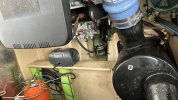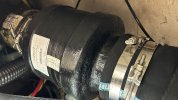racurry@unb.ca
Active member
- Joined
- Oct 30, 2022
- Messages
- 33
- Fluid Motion Model
- R-23 (Sterndrive)
- Vessel Name
- Water Weaver
I wanted to start this Topic to amalgamate our conversations which are split among several topic titles when you search "hydro lock", its variants, and other related key words. I am going through this major problem currently. There is good information on this Topic in Tugnuts - BB Marine, Osprey, Sine Wave for example.
I am not a mechanic and my starting explanations will be simple, but after >3000 NM over the last 10 months on my Cutwater, I have experienced a few things and this is the biggest issue that every Cutwater owner needs to know today. The experts can add more as the topic discussion grows.
To begin, Fluid Motion does not provide this information in any manual or webinar on the very real, dangerous, and expensive problem of water ingression into your Cutwater's inline diesel engine. My boat is a 2016 C30 Sedan with a Volvo Penta D6-435 with a wet / lift exhaust.
Challenge #1 - Engine won't start: If your engine won't start but you can turn it over, close your seacock on the engine water intake before you try to address the engine problem. The system is drawing water when the engine is turning over and that water has nowhere to go except to accumulate in your muffler where it can't get discharged offboard without the engine running. This means water is collecting and backing up into your turbocharger and then your engine. Searching around, I read that 15 seconds is the maximum time you should turnover your engine without it starting and your seacock open. The added challenge in this situation is that your engine can turn over, but it may not have enough cranking power left to start the engine, which leads to the >15 seconds of trying. You won't readily know your battery power challenge without an accurate power level reading from the battery itself, plus experience / knowledge of this engine-battery relationship for your boat.
Challenge #2 - Anchored in Rough Waters: As your boat rocks at anchor, the boat exhaust flapper on the outside of the hull, where the exhaust hose connects, should close to prevent water ingression. Check it at dock and if it flaps easily, then when you are anchored in rough water without your engine running, water is entering into the exhaust hose. Next, check your Cutwater's exhaust system layout. On my boat and many others across the Tugnut world, the design is NOT sufficient to keep that ingression of water from reaching your muffler. My exhaust line rises a maximum 14" above the water line in a straight-line (72") with no check valve before it drops directly into the muffler. When the boat is rocking and water enters via the flappers, it is accumulating in the muffler, and once filled, the rocking can lead to water enter into the turbocharger, which in my case is a <12'" rise over 23" length of hose, and then into your engine. I'll post some diagrams and pictures of my boat. There is more to read in other Tugnut threads.
Challenge #3 - Towing Your Boat on Water Part 1: As occurs in Challenge #2, towing in rough waters creates the same water ingression via the flappers-exhaust hose-muffler-turbocharger pathway.
Challenge #4 - Towing Your Boat on Water Part 2: Your water intake for the engine cooling system most probably draws water from a forward opening on the hull, i.e., the opening is towards the bow. When towing on water, a pressure gradient is created which pushes water through the seacock all the way to the muffler in some instances. Again, once your muffler is full it back fills up to the turbocharge and then your engine. There is a good Tugnut thread about this too.
Challenge #5 - Your Shaft Seal / Stuffing Box: This bearing system is water cooled via a line from your engine's water intake system. In another thread, you can read about incidents where that water can be syphoned back into the muffler and then the engine as described above. I don't fully understand his one, but others in Tugnuts describe it well.
Solutions: I can only offer the easy ones to start.
TOWING ON WATER - Any towing on water demands that your seacocks are CLOSED. I don't have a solution for the Flapper issue yet.
ENGINE TURNING OVER - If your engine doesn't start after 15 seconds of turning it over and your battery still has enough power to start the engine, close the water intake seacock before continuing to turn-over your engine.
EXHAUST SYSTEM MAKEOVERS - First, it would be very helpful if Fluid Motion put out a warning about their minimally designed exhaust systems. They know the issue and they know that many of us have suffered through the unhappiness of not knowing upfront. Most of us have poured through manuals, videos, Tugnuts, and other forums studying our boats, but until you have a specific problem, you can't possibly catch every issue for these boats, and this is a big one everyone needs to know upfront. It would also be useful if Fluid Motion offered up some solutions from the factory or at least some DIYs before the issue arises. Osprey has a muffler drain valve that I'm currently considering.
That is all for now. Allen www.weavingwatersexpedition.com
I am not a mechanic and my starting explanations will be simple, but after >3000 NM over the last 10 months on my Cutwater, I have experienced a few things and this is the biggest issue that every Cutwater owner needs to know today. The experts can add more as the topic discussion grows.
To begin, Fluid Motion does not provide this information in any manual or webinar on the very real, dangerous, and expensive problem of water ingression into your Cutwater's inline diesel engine. My boat is a 2016 C30 Sedan with a Volvo Penta D6-435 with a wet / lift exhaust.
Challenge #1 - Engine won't start: If your engine won't start but you can turn it over, close your seacock on the engine water intake before you try to address the engine problem. The system is drawing water when the engine is turning over and that water has nowhere to go except to accumulate in your muffler where it can't get discharged offboard without the engine running. This means water is collecting and backing up into your turbocharger and then your engine. Searching around, I read that 15 seconds is the maximum time you should turnover your engine without it starting and your seacock open. The added challenge in this situation is that your engine can turn over, but it may not have enough cranking power left to start the engine, which leads to the >15 seconds of trying. You won't readily know your battery power challenge without an accurate power level reading from the battery itself, plus experience / knowledge of this engine-battery relationship for your boat.
Challenge #2 - Anchored in Rough Waters: As your boat rocks at anchor, the boat exhaust flapper on the outside of the hull, where the exhaust hose connects, should close to prevent water ingression. Check it at dock and if it flaps easily, then when you are anchored in rough water without your engine running, water is entering into the exhaust hose. Next, check your Cutwater's exhaust system layout. On my boat and many others across the Tugnut world, the design is NOT sufficient to keep that ingression of water from reaching your muffler. My exhaust line rises a maximum 14" above the water line in a straight-line (72") with no check valve before it drops directly into the muffler. When the boat is rocking and water enters via the flappers, it is accumulating in the muffler, and once filled, the rocking can lead to water enter into the turbocharger, which in my case is a <12'" rise over 23" length of hose, and then into your engine. I'll post some diagrams and pictures of my boat. There is more to read in other Tugnut threads.
Challenge #3 - Towing Your Boat on Water Part 1: As occurs in Challenge #2, towing in rough waters creates the same water ingression via the flappers-exhaust hose-muffler-turbocharger pathway.
Challenge #4 - Towing Your Boat on Water Part 2: Your water intake for the engine cooling system most probably draws water from a forward opening on the hull, i.e., the opening is towards the bow. When towing on water, a pressure gradient is created which pushes water through the seacock all the way to the muffler in some instances. Again, once your muffler is full it back fills up to the turbocharge and then your engine. There is a good Tugnut thread about this too.
Challenge #5 - Your Shaft Seal / Stuffing Box: This bearing system is water cooled via a line from your engine's water intake system. In another thread, you can read about incidents where that water can be syphoned back into the muffler and then the engine as described above. I don't fully understand his one, but others in Tugnuts describe it well.
Solutions: I can only offer the easy ones to start.
TOWING ON WATER - Any towing on water demands that your seacocks are CLOSED. I don't have a solution for the Flapper issue yet.
ENGINE TURNING OVER - If your engine doesn't start after 15 seconds of turning it over and your battery still has enough power to start the engine, close the water intake seacock before continuing to turn-over your engine.
EXHAUST SYSTEM MAKEOVERS - First, it would be very helpful if Fluid Motion put out a warning about their minimally designed exhaust systems. They know the issue and they know that many of us have suffered through the unhappiness of not knowing upfront. Most of us have poured through manuals, videos, Tugnuts, and other forums studying our boats, but until you have a specific problem, you can't possibly catch every issue for these boats, and this is a big one everyone needs to know upfront. It would also be useful if Fluid Motion offered up some solutions from the factory or at least some DIYs before the issue arises. Osprey has a muffler drain valve that I'm currently considering.
That is all for now. Allen www.weavingwatersexpedition.com


